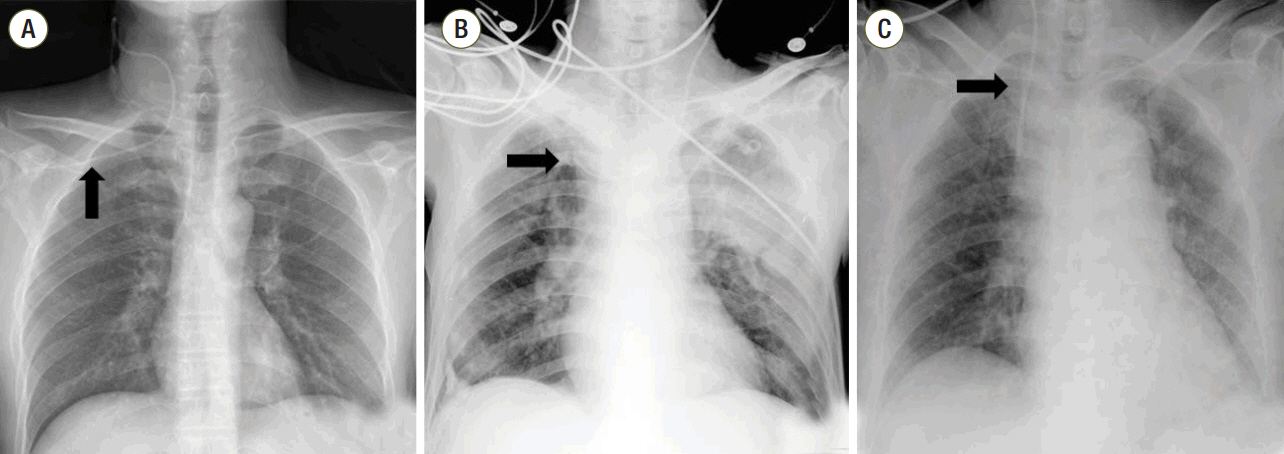Korean J Crit Care Med.
2015 Nov;30(4):280-285. 10.4266/kjccm.2015.30.4.280.
Direction of the J-Tip of the Guidewire to Decrease the Malposition Rate of an Internal Jugular Vein Catheter
- Affiliations
-
- 1Department of Emergency Medicine, College of Medicine, Chungnam National University Hospital, Daejeon, Korea. boxter73@cnuh.co.kr
- KMID: 2156181
- DOI: http://doi.org/10.4266/kjccm.2015.30.4.280
Abstract
- BACKGROUND
We hypothesized that the direction of the J-tip of the guidewire during insertion into the internal jugular vein (IJV) might determine its ultimate location.
METHODS
In this study, 300 patients between the ages of 18 and 99 years who required central venous catheterization via IJV in the emergency department enrolled for randomization. IVJ catheterization was successful in 285 of 300 patients. An independent operator randomly prefixed the direction of the J-tip of the guidewire to one of three directions. Based on the direction of the J-tip, patients were allocated into three groups: the J-tip medial-directed group (Group A), the lateral-directed group (Group B), or the downward-directed group (Group C). Postoperative chest radiography was performed on all patients in order to visualize the location of the catheter tip. A catheter is considered malpositioned if it is not located in the superior vena cava or right atrium.
RESULTS
Of the total malpositioned catheter tips (8 of 285; 2.8%), the majority (5 of 8; 62.5%) entered the contralateral subclavian vein, 2 (25.0%) were complicated by looping, and 1 (12.5%) entered the ipsilateral subclavian vein. According to the direction of the J-tip of the guidewire, the incidence of malpositioning of the catheter tip was 4 of 92 in Group A (4.3%), 4 of 96 in Group B (4.2%), and there were no malpositions in Group C. There were no significant differences among the three groups (p = 0.114).
CONCLUSIONS
The direction of the J-tip of the guidewire had no statistically significant effect on incidence of malpositioned tips.
MeSH Terms
Figure
Reference
-
References
1. Miller AH, Roth BA, Mills TJ, Woody JR, Longmor CE, Foster B. Ultrasound guidance versus landmark technique for the placement of central venous catheters in the emergency department. Acad Emeg Med. 2002; 9:800–5.2. Ruesch S, Walder B, Tramèr MR. Complications of central venous catheters: internal jugular versus subclavian access--a systematic review. Crit Care Med. 2002; 30:454–60.
Article3. Boardman P, Hughes JP. Radiological evaluation and management of malfunctioning central venous catheters. Clin Radiol. 1998; 53:10–6.4. Oh AY, Jeon YT, Choi EJ, Ryu JH, Hang JW, Park HP, et al. The influence of the direction of J-tip on placement of a subclavian catheter: real time ultrasound-guided cannulation versus landmark method, a randomized controlled trial. BMC Anesthesiology. 2014; 14:11.
Article5. Sanchez R, Halck S, Walther-Lasen S, Heslet L. Misplacement of subclavian venous catheters: importance of head position and choice of puncture site. Br J Anaesth. 1990; 64:632–3.
Article6. Kang M, Ryu HG, Son IS, Bahk JH. Influence of shoulder position on central venous catheter tip location during infraclavicular subclavian approach. Br J Anaesth. 2011; 106:344–7.
Article7. Tripathi M, Dubey PK, Ambesh SP. Direction of the J-tip of the guidewire, in seldinger technique, is a significant factor in misplacement of subclavian vein catheter: a randomized, controlled study. Anesth Analg. 2005; 100:21–4.
Article8. Ahn H, Kim G, Cho B, Jeong W, Yoo Y, Ryu S, et al. How to decrease the malposition rate of central venous catheterization: real-time ultrasound-guided reposition. Korean J Crit Care Med. 2013; 28:280–6.
Article9. Leung J, Duffy M, Finckh A. Real-time ultrasonographically-guided internal jugular vein catheterization in the emergency department increases success rates and reduces complications: a randomized, prospective study. Ann Emerg Med. 2006; 48:540–7.
Article10. Felleiter P, Gustorff B, Lierz P, Hӧrauf K. Use of electrocardiographic placement control of central venous catheters in Austria. Acta Med Austriaca. 1999; 26:109–13.11. Wang HE, Sweeney TA. Subclavian central venous catheterization complicated by guidewire looping and entrapment. J Emerg Med. 1999; 17:721–4.
Article12. Maffessanti M, Bortolotto P, Kette F. Malpositions and complications following central venous catheterization in relation to the access site. Radiol Med. 1988; 75:609–12.13. Muhm M, Sunder-Plassmann G, Apsner R, Pernerstorfer T, Rajek A, Lassingg A, et al. Malposition of central venous catheters. Incidence, management and preventive practices. Wien Klin Wochenschr. 1997; 109:400–5.14. Bagwell CE, Salzberg AM, Sonnino RE, Haynes JH. Potentially lethal complications of central venous catheter placement. J Pediatr Surg. 2000; 35:709–13.
Article15. McGee WT, Ackerman BL, Rouben LR, Prasad VM, Bandi V, Mallory DL. Accurate placement of central venous catheters: a prospective, randomized, multicenter trial. Crit Care Med. 1993; 21:1118–23.16. Peres PW. Positioning central venous catheters--a prospective survey. Anaesth Intensive Care. 1990; 18:536–9.17. Vesely TM. Central venous catheter tip position: a continuing controversy. J Vasc Interv Radiol. 2003; 14:527–34.
Article
- Full Text Links
- Actions
-
Cited
- CITED
-
- Close
- Share
- Similar articles
-
- Malposition of a Subclavian Catheter in the Internal Jugular Vein Due to the Direction of a J-type Guidewire End
- Cardiac Tamponade Developed in 12 Hours after Left Internal Jugular Cannulation: A case report
- Does the direction of J-tip of the guide-wire influence the misplacement of subclavian catheterization?
- Catheter malposition rate following right subclavian venous catheterization
- Roentgenographic Confirmation of Central Venous Catheter Tips Through the Basilic and External Jugular Veins




